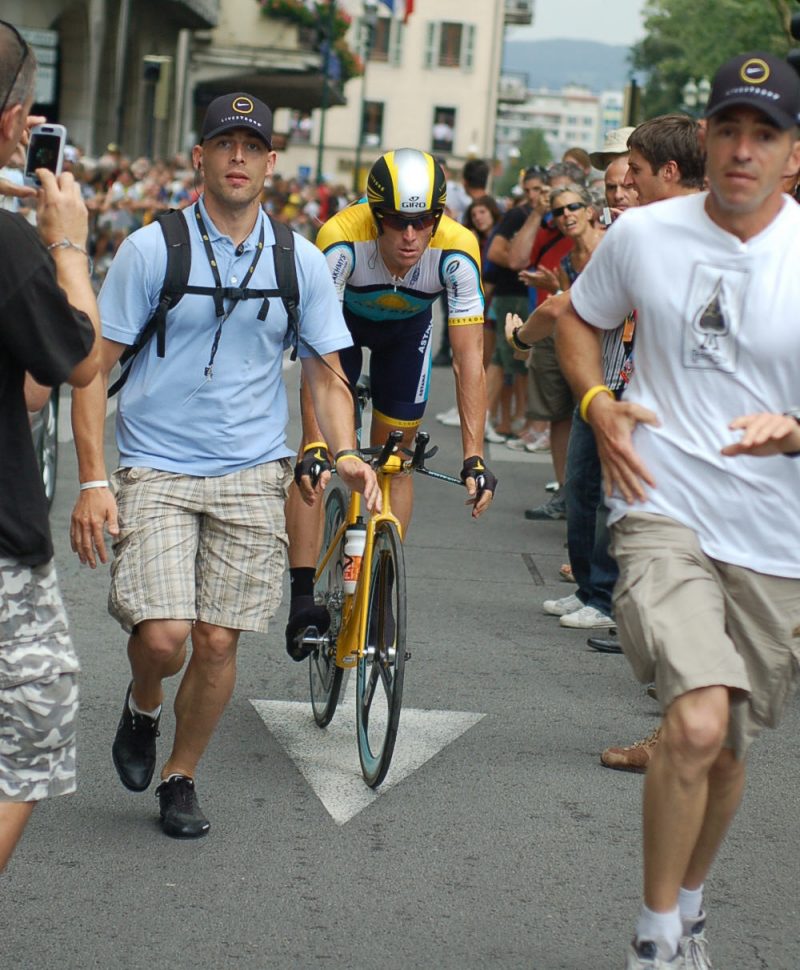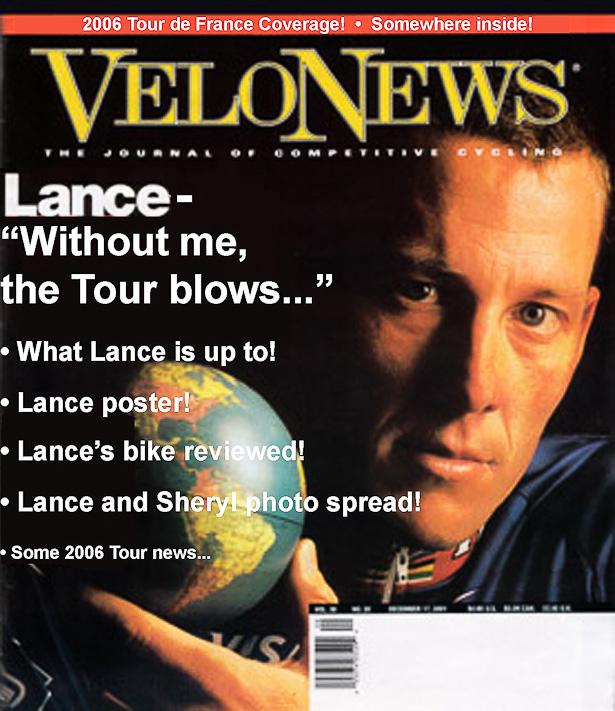
Despite the Lance Armstrong Scandal, it’s not hard to dislike Lance Armstrong; he’s arrogant, controlling, self-obsessed, hypocritical and brought to cycling the horrors of bodyguards, blacked-out SUV windows, black socks and celebrity visits to the Tour de France.
He scarcely bothers to conceal his contempt for journalists, but used them to ‘spread the gospel’ when it was convenient.
But on the other hand, it is hard to dislike Michael Barry – smiling, polite, helpful, intelligent and grounded; a pleasure to meet and interview.
But here’s the rub – they both regularly ‘kitted up’ as part of their stage race regime.
So how come one is a ‘monster’ and one is a ‘victim?’
It’s a difficult question, I think?
I was never a Lance fan on his first ‘tour of duty’ – but when he came back, I have to say that I admired the man.
He was fourth in a tough Vuelta a España, then fourth in the World Time Trial Championships and occupied the same position in a gruesomely hard World Road Race.
Oscar Camenzind won that one – I wonder whatever happened to him?…
But then came the Tour wins, the increasingly shorter seasons, the bodyguards, the celebrity lifestyle and a feeling that it was all too good to be true.
Not normal
But when I really and fully realised how much it all stank, this Lance Armstrong Scandal, was during year two of the second comeback.

In 2009 he’d finished third in le Tour and with a good winter behind him and his legendary dedication to training, diet and ‘the other stuff’ which goes with being Lance, another step up the podium looked well feasible.
In 2010 he finished third in the Tour of Luxembourg, second in the Tour de Suisse and it looked set fair for a cracking Tour de France.
But around this time, a red headed ghost began to wander The Shack battlements.
His name was Floyd Landis and he was haunting all sorts of people; the UCi, team officials – and Lance.
As the karma turned on them, Lance and Bruyneel knew that their every move in the Tour would be scrutinised even more closely than usual – the ‘hot sauce’ very obviously had to stay in the pantry.
An ordinary looking Lance Armstrong finished in 23rd place at 39 minutes, one place ahead of Bradley Wiggins.
It was simply too obvious to be true, if you knew what you were looking at.
The journalists were complicit
But there’s little you can say in print; observe how his legal team are still battling, despite an unstable slag heap of damning evidence sliding inexorably towards them.
And the magazine editors who now demand that the Texan should be ‘hanged high’ and tell us we were ‘all complicit’ should have a wee look back at their own front covers from the ‘Lance Eras.’

I must confess that I never thought he’d go down; my thought was that he’s like the flag and mom’s apple pie – part of what makes America great.
What I think now is that it’s highly unlikely that the campaign against Lance was motivated by anything other than politics and the personal desire of certain individuals to see him fall.
They’ve certainly accomplished that.
His 2009 comeback was allegedly designed to push his name back into the public consciousness in anticipation of a move into politics after what was surely going to be another stellar Tour in 2010.
Remember that Armstrong is a staunch Republican, a buddy of George W Bush and a bona fide “All American Hero”.
Whilst his downfall has done the United States’ image no favours on the world stage, at home it’s another example of; ‘those damn Republicans thinking they can get away with anything!’
I have little sympathy for Armstrong but still don’t think that’s what’s happening is in the best interests of the sport. On the contrary, I think it’s been set back a couple of years, at least.

They’re all at it, aren’t they?
Maybe I’m getting old and soft but I find it utterly depressing to have to have to defend the sport to friends and colleagues;
“Yes, Armstrong is guilty as sin, but it’s much better now and you don’t have team wide organised doping culture.”
But then they say;
“What about that Contador boy? Didn’t you say that when they nabbed him?’
And no one is that interested in Argentinean beef imports to Spain.
My son clued me in that ‘Talk Sport Radio’ had Lance as a subject on Thursday; the rubbish that was being broadcast on national radio was stupefying.
“Nine of the 11 riders who testified against Lance had previous convictions for doping”
and how about;
“Those motorbikes on the race are all used to transport the drugs.”
They wheeled out David Walsh who informed us that Armstrong;
“…came from the middle rankings of the peloton before he won the Tour, and his first Tour mountain stage win was too good to be true.”
At that stage in his career Armstrong had been World Professional Road Race Champion and had finished fourth the previous autumn in the Vuelta.
This rubbish and disinformation, which is pedalled as truth, only serves to exacerbate the ‘all cyclists take drugs’ offal which much of the media churns out.
Incidentally, I’ve never seen a cycling article written by David Walsh which deals with anything other than Armstrong and drugs.
See no evil, hear no evil
Maybe newcomers to the sport will be shocked by the recent ‘USPS Conspiracy’ revelations, but in the next few days we’ll be re-printing an interview we did with Joe Papp a couple of years ago. [Joe was caught, fessed up and is still paying for his indiscretions, Editor.]
When you read what Joe’s team was administering to him and his team-mates in 2006 – in preparation for their registering as Continental in ’07 – then extrapolate that through to Pro Continental then Pro Tour, it’s not difficult to figure out that it would be really heavy duty come the serious Grand Tour winning teams.

Here’s what ex-Kelme rider, Jesus Manzano (the man whose revelations sparked Operation Puerto) said way back in 2004;
“I’d ‘puncture’ myself 12 or 13 times a day, including injecting with EPO (sometimes twice a day) and doing my own blood tests.
“On some days I’d measure my hematocrit four times: once in the morning, once after training, once in the late afternoon and once at night.
“Then I’d take doses of growth hormone, folic acid, vitamin B-12 and iron, and finally serum and aspirins to stop the blood thickening too much.
“And there are some days that you have to inject cortisone or HMG, which is a male hormone to balance the testosterone with epitestosterone, or you take some cofactor, like Geref, Neofertin, things like that, that are expensive treatments compared to the ones we have already spoken about.”
That was eight years ago and all of his comments were in the public domain.
But as with Hamilton and Landis, nothing was done by the UCi, he wasn’t brought in and quizzed – it was the Spanish authorities who initiated Puerto.
This brings me to one of the points of this piece; it was the UCi who created the climate which allowed doping to flourish.
In his book The Secret Race Tyler Hamilton refers to ‘playing by the rules’ – by this he means keeping his hematocrit below 50 – but the word ‘rules’ implies that a huge game was being played.
There was really just one rule; ‘don’t get caught.’
It was the UCI who made those rules, accepted payments from Armstrong and facilitated him in meeting the bosses of the drug testing laboratories.
What amazes me is; why weren’t the national federations up in arms when Lance’s ‘bungs’ came to light? There must be someone in the middle reaches of the UCi who feels they could do a better job than the current worn out cartel?
Or perhaps it’s the case that like some Stalinist regime, the men at the top have it stitched up so tight that no one else can move against them?
When the contents of the cesspit which have so spectacularly been depth-charged finally settle, we should not forget what Verbruggen and McQuaid presided over.
It should have stopped with Gewiss-Ballan
Or Festina.
Or Pantani.
Or Landis…
A line should have been drawn in the sand – but no, it went on, and on.
The UCI should have dragged the DSs and managers into a room with no ‘phones and no minutes taken and said; “It stops, now!”
Lance is a scandal too far.
But let’s go back to the ‘monster or victim’ question which I started this article with.
There’s no easy answer, just more questions.
If you were in that passenger plane which crashed in high in the Andes and faced the choice of cannibalism or death, which would you choose?
And if you’d dreamed of nothing but being a professional cyclist since you first saw that picture of Greg LeMond on the Champs Elysees, and the time came to chose – ‘kit up‘ and do the business against the Europeans, or go back to changing in village halls and a job in the local bike shop, what would you do?
The only answer I could give to both questions is; ‘I wouldn’t know ‘til you placed me in that situation.’
If you’re certain that you’d starve to death or go back to club races – you’re a better man than me.



